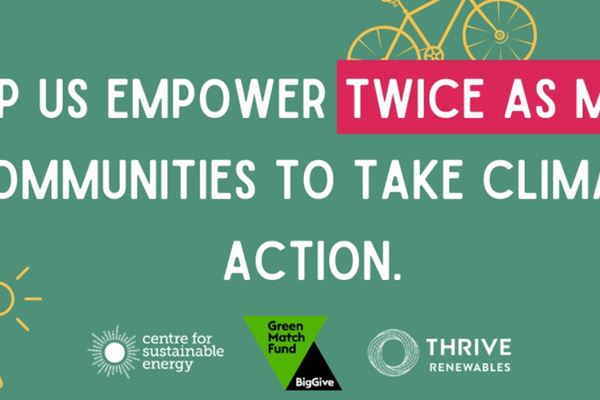There’s no doubt that 2022 has been challenging for people and planet. Following Russia’s invasion of Ukraine, we’ve seen the fragility of the UK’s energy security exposed (alongside many other EU countries), with millions left struggling to pay their energy bills as a result.
Despite the global energy crisis, it’s important that we acknowledge the things that have improved this year – and there have definitely been some encouraging signs of progress. In fact, a recent report by the International Energy Agency (IEA) has found that the energy crisis has triggered unprecedented momentum for renewables, with the world set to add as much renewable power in the next five years as it has in the past 20.
Thrive has certainly made significant headway in 2022. As well as starting construction on our largest battery project to date – a 20MW site in our hometown of Bristol, we provided a £4 million loan to Ambition Community Energy so that they could build England’s largest, 100% community-owned onshore wind turbine. Helping to ensure the benefits of renewable energy stay local, the turbine will generate enough clean electricity to cover the community’s domestic energy use and any profits from electricity sales will be fed back into local causes. We also funded the installation of a number of rooftop solar arrays through our work with Olympus Power, helping more UK businesses to reduce their emissions and play their part in the acceleration of net zero. To top it off, we successfully crowdfunded £6.8 million, which will help us deliver more onshore wind, rooftop solar and battery storage projects in the months to come.
As we start a new year, we’ve put together our renewables ‘wish list’ for 2023, outlining what we would like to see prioritised as we work towards a low-carbon future here in the UK.

1. Growing the UK’s energy independence
Millions of households have been impacted by soaring energy prices, with data from the Energy and Climate Intelligence Unit (ECIU) finding that the wholesale gas crisis will have added £4,400 to the average UK household’s energy bill by 2024.
Highlighting how dependent the UK has been on imported gas, the country is now increasingly having to rely on liquified natural gas (LNG) as a way to replace Russian supply. The problem with this is the additional processing of LNG is even more greenhouse gas intensive than pipeline gas, generating between 61% and 176% more greenhouse gas emissions. So, this short-term fix to satisfy gas demand will have major consequences for the environment.
As if we didn’t know it already, the energy crisis has further demonstrated our need for clean, homegrown power. Technologies such as onshore wind and solar are quick to deploy and can be delivering cost savings to consumers within a year. We want to see the government facilitating the deployment of technologies that build the way to a smarter, cleaner and more secure energy market in the UK.

2. Greater clarity and a level playing field for onshore wind
As you may have read in our last blog, onshore wind is back on the agenda – with the government recently announcing a consultation on removing the de facto ban put in place in 2015. Expected to conclude in April 2023, the government will be looking to remove the additional planning hurdles for the development of new onshore wind farms in places with local support.
What we really need to know is: what constitutes community support and how will it need to be evidenced? Until this happens, ready-to-go projects will remain stuck in the planning process and this seems crazy in the face of a country-wide energy crisis, especially as onshore wind is one of the cheapest and quickest technologies to deploy. What we’d really like to see is a level playing field for onshore wind and a return to planning policy that puts onshore wind ‘in line with other infrastructure projects’. The current planning regime already takes into account local support, ecology and land use for any project.

3. Moving forwards on market reform so people can benefit from low-cost renewables
Earlier this year, the government announced a review into the UK’s electricity system (REMA), looking at how, amongst other things, we could decouple the wholesale electricity market price from fossil fuels. As the review progresses, we want to see acknowledgement of the benefits of moving from a marginal price model to a price of capacity model. This would give consumers greater transparency around the cost savings associated with renewables, in turn helping to bolster support, drive investment and accelerate the transition.
If done correctly, we believe that reform of the current structure will be a positive move and will support the UK’s acceleration towards a clean energy system. However, it’s important that the government works together with investors and developers when it comes to next steps.

4. Making the most of the space we have available
At the COP26 conference in Glasgow, the government pledged to decarbonise the electricity system by 2035. To ensure that the UK’s electricity is predominantly generated by renewables and other low-carbon technologies by 2035, we need to make the most of the areas we have available for development. This means utilising things like rooftops and other commercial spaces such as car parks.
Direct wire or on-site renewables are a great way to support businesses in reducing their carbon emissions, with the clean electricity helping to power their operations and any surplus being exported to the grid. Analysis from CPRE, the countryside charity, has found that if only a quarter of the UK’s total 250,000 hectares of south-facing commercial roof space was useable, it could generate 25GW of electricity annually. This is supported by data from PowerMarket which also revealed that, if the UK used just 5% of the available commercial rooftop space for solar, it could lead to an estimated £12.6 billion per year in energy cost savings.

5. Bridging the renewables skills gap
According to PwC’s annual green jobs barometer, the number of jobs being created in the renewable energy industry is growing four times faster than the overall UK employment market.
But, while it’s great to see the number of green jobs growing, it’s still felt that there is a lack of quality applicants to fill them. We think it’s important for the government to support green careers as part of the national curriculum, but we’d also like to see more support going towards conversion courses and upskilling so that the talented individuals working within the oil and gas sector – for example – feel empowered to make the transition into renewables.
Yes, nurturing talent from a young age is important but we shouldn’t miss out on the huge number of skilled workers who, with some further training, would be ready to help the industry grow at the scale required.



